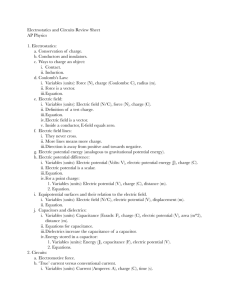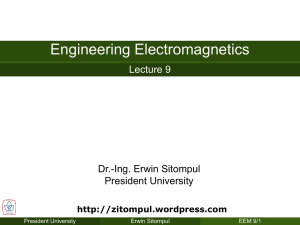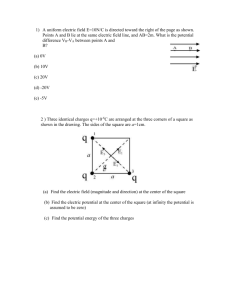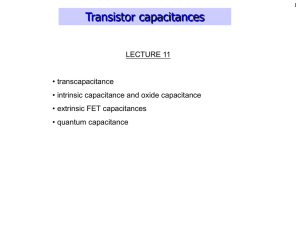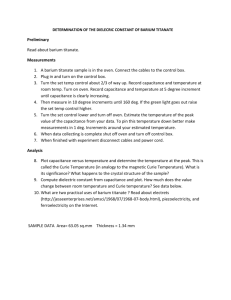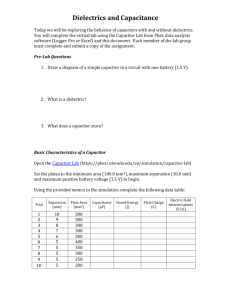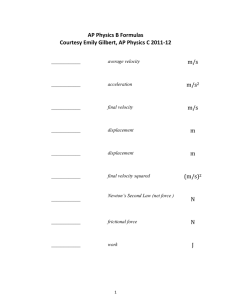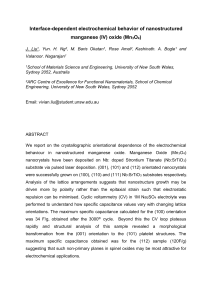capacitance - Erwin Sitompul
advertisement
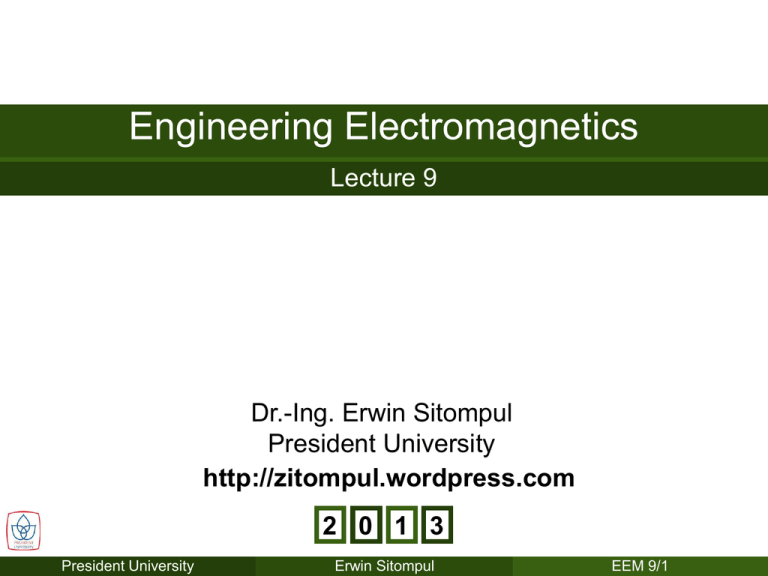
Engineering Electromagnetics Lecture 9 Dr.-Ing. Erwin Sitompul President University http://zitompul.wordpress.com 2 0 1 3 President University Erwin Sitompul EEM 9/1 Chapter 6 Dielectrics and Capacitance Capacitance Now let us consider two conductors embedded in a homogenous dielectric. Conductor M2 carries a total positive charge Q, and M1 carries an equal negative charge –Q. No other charges present the total charge of the system is zero. • The charge is carried on the surface as a surface charge density. • The electric field is normal to the conductor surface. • Each conductor is an equipotential surface President University Erwin Sitompul EEM 9/2 Chapter 6 Dielectrics and Capacitance Capacitance The electric flux is directed from M2 to M1, thus M2 is at the more positive potential. Works must be done to carry a positive charge from M1 to M2. Let us assign V0 as the potential difference between M2 and M1. We may now define the capacitance of this two-conductor system as the ratio of the magnitude of the total charge on either conductor to the magnitude of the potential difference between the conductors. Q C V0 President University Erwin Sitompul C S E dS E dL EEM 9/3 Chapter 6 Dielectrics and Capacitance Capacitance The capacitance is independent of the potential and total charge for their ratio is constant. If the charge density is increased by a factor, Gauss's law indicates that the electric flux density or electric field intensity also increases by the same factor, as does the potential difference. C S E dS E dL Capacitance is a function only of the physical dimensions of the system of conductors and of the permittivity of the homogenous dielectric. Capacitance is measured in farads (F), 1 F = 1 C/V. President University Erwin Sitompul EEM 9/4 Chapter 6 Dielectrics and Capacitance Capacitance We will now apply the definition of capacitance to a simple twoconductor system, where the conductors are identical, infinite parallel planes, and separated a distance d to each other. S E az D S a z The charge on the lower plane is positive, since D is upward. DN Dz S The charge on the upper plane is negative, DN Dz S President University Erwin Sitompul EEM 9/5 Chapter 6 Dielectrics and Capacitance Capacitance The potential difference between lower and upper planes is: V0 lower upper E dL 0 d S S dz d The total charge for an area S of either plane, both with linear dimensions much greater than their separation d, is: Q S S The capacitance of a portion of the infinite-plane arrangement, far from the edges, is: C Q S V0 d President University Erwin Sitompul EEM 9/6 Chapter 6 Dielectrics and Capacitance Capacitance Example Calculate the capacitance of a parallel-plate capacitor having a mica dielectric, εr = 6, a plate area of 10 in2, and a separation of 0.01 in. S 10 in 2 10 in 2 (2.54 102 m in) 2 6.452 103 m2 C d (6)(8.854 1012 )(6.452 10 3 ) 2.54 104 1.349 nF d 0.01 in 0.01in (2.54 102 m in) 2.54 104 m President University S Erwin Sitompul EEM 9/7 Chapter 6 Dielectrics and Capacitance Capacitance The total energy stored in the capacitor is: WE 12 E 2 dv vol 2 S 1 2 dv vol 2 1 S d S 2 dzdS 0 0 2 12 S Sd 2 1 S S 2 2 d d 2 C V0 d S d Q C V0 2 Q WE 12 CV02 12 QV0 12 C President University S Erwin Sitompul EEM 9/8 Chapter 6 Dielectrics and Capacitance Several Capacitance Examples As first example, consider a coaxial cable or coaxial capacitor of inner radius a, outer radius b, and length L. L a The capacitance is given by: V ln 2 ab Q 2 L C Vab ln(b a) b Q L L Next, consider a spherical capacitor formed of two concentric spherical conducting shells of radius a and b, b>a. Q 4 C Vab 1 1 a b President University Q Vab 4 Erwin Sitompul EEM 9/9 1 1 a b Chapter 6 Dielectrics and Capacitance Several Capacitance Examples If we allow the outer sphere to become infinitely large, we obtain the capacitance of an isolated spherical conductor: C 4 a A sphere about the size of a marble, with a diameter of 1 cm, will have: C 0.556 pF Coating this sphere with a different dielectric layer, for which ε = ε1, extending from r = a to r = r1, Q Dr 4 r 2 Q Er (a r r1 ) 2 41r Q (r r1 ) 4 0 r 2 President University Erwin Sitompul EEM 9/10 Chapter 6 Dielectrics and Capacitance Several Capacitance Examples While the potential difference is: a Qdr r1 Qdr Va V r1 4 r 2 4 r 2 1 0 Q 4 1 1 1 1 a r r 1 0 1 1 Therefore, 4 C 1 1 1 1 1 a r1 0 r1 President University Erwin Sitompul EEM 9/11 Chapter 6 Dielectrics and Capacitance Several Capacitance Examples A capacitor can be made up of several dielectrics. Consider a parallel-plate capacitor of area S and spacing d, d << linear dimension of S. The capacitance is ε1S/d, using a dielectric of permittivity ε1. Now, let us replace a part of this dielectric by another of permittivity ε2, placing the boundary between the two dielectrics parallel to the plates. • Assuming a charge Q on one plate, ρS = Q/S, while DN1 = DN2, since D is only normal to the boundary. • E1 = D1/ε1 = Q/(ε1S), E2 = D2/ε2 = Q/(ε2S). • V1 = E1d1, V2 = E2d2. Q 1 Q 1 C d1 d 1 1 V1 V2 V0 2 1S 2 S C1 C2 President University Erwin Sitompul EEM 9/12 Chapter 6 Dielectrics and Capacitance Several Capacitance Examples Another configuration is when the dielectric boundary were placed normal to the two conducting plates and the dielectrics occupied areas of S1 and S2. • Assuming a charge Q on one plate, Q = ρS1S1 + ρS2S2. • ρS1 = D1 = ε1E1, ρS2 = D2 = ε2E2. • V0 = E1d = E2d. Q 1S1 2 S 2 C C1 C2 d V0 President University Erwin Sitompul EEM 9/13 Chapter 6 Dielectrics and Capacitance Capacitance of a Two-Wire Line The configuration of the two-wire line consists of two parallel conducting cylinders, each of circular cross section. We shall be able to find complete information about the electric field intensity, the potential field, the surface charge density distribution, and the capacitance. This arrangement is an important type of transmission line. • Schematics of a transmission line President University Erwin Sitompul EEM 9/14 Chapter 6 Dielectrics and Capacitance Capacitance of a Two-Wire Line The capacitance, together with conductance, forms a shunt admittance of a transmission line. The line capacitance is proportional to the length of the transmission line. When an alternating voltage is applied to the line, the line capacitance draws a leading sinusoidal current, called the charging current. The charging current is negligible for lines less than 100 km long. For longer lines, the capacitance becomes increasingly important and has to be accounted for. The value of such capacitance is significantly higher with underground cables than with overhead lines, due to the close proximity of the individual conductors. President University Erwin Sitompul EEM 9/15 Chapter 6 Dielectrics and Capacitance Capacitance of a Two-Wire Line The potential field of two infinite line charges, with a positive line charge in the xz plane at x = a and a negative line at x = –a, is shown below. The potential of a single line charge with zero reference at a radius of R0 is: R0 L V ln 2 R The combined potential field can be written as: R10 R2 L R20 L R10 ln V ln ln 2 R1 R2 2 R20 R1 President University Erwin Sitompul EEM 9/16 Chapter 6 Dielectrics and Capacitance Capacitance of a Two-Wire Line We choose R10 = R20, thus placing the zero reference at equal distances from each line. Expressing R1 and R2 in terms of x and y, L ( x a)2 y 2 L ( x a) 2 y 2 ln V ln 2 2 4 ( x a)2 y 2 2 ( x a) y To recognize the equipotential surfaces, some algebraic manipulations are necessary. Choosing an equipotential surface V = V1, we define a dimensionless parameter K1 as: K1 e 4V1 L so that ( x a) 2 y 2 K1 ( x a) 2 y 2 President University Erwin Sitompul EEM 9/17 Chapter 6 Dielectrics and Capacitance Capacitance of a Two-Wire Line After some multiplications and algebra, we obtain: K1 1 2 x 2ax y2 a2 0 K1 1 2 2 2a K1 K1 1 2 xa y K1 1 K 1 1 The last equation shows that the V = V1 equipotential surface is independent of z and intersects the xy plane in a circle of radius b, 2a K1 b K1 1 The center of the circle is x = h, y = 0, where: K1 1 ha K1 1 President University Erwin Sitompul EEM 9/18 Chapter 6 Dielectrics and Capacitance Capacitance of a Two-Wire Line Let us now consider a zero-potential conducting plane located at x = 0, and a conducting cylinder of radius b and potential V0 with its axis located a distance h from the plane. Solving the last two equations for a and K1 in terms of b and h, a h2 b2 h h2 b2 K1 b The potential of the cylinder is V0, so that: K1 e2V0 L Therefore, 4V0 2V0 L ln K1 ln K1 President University Erwin Sitompul EEM 9/19 Chapter 6 Dielectrics and Capacitance Capacitance of a Two-Wire Line Given h, b, and V0, we may determine a, K1, and ρL. The capacitance between the cylinder and the plane is now available. For a length L in the z direction, C C L L V0 4 L 2 L ln K1 ln K1 2 L ln h h2 b 2 2 L 1 cosh ( h b) b • Prove the equity by solving quadratic equation in eα, where cosh(α)=h/b. • cosh(α) = (eα+e–α )/2 President University Erwin Sitompul EEM 9/20 Chapter 6 Dielectrics and Capacitance Capacitance of a Two-Wire Line Example The black circle shows the cross section of a cylinder of 5 m radius at a potential of 100 V in free space. Its axis is 13 m away from a plane at zero potential. b 5, h 13, V0 100 a h2 b2 132 52 12 h h2 b2 13 12 K1 5 K1 25 b 5 4 V0 4 (8.854 1012 )(100) L 3.46 nC m ln K1 ln 25 2 (8.854 1012 ) 2 34.6 pF m C 1 1 cosh (13 5) cosh (h b) President University Erwin Sitompul EEM 9/21 Chapter 6 Dielectrics and Capacitance Capacitance of a Two-Wire Line We may also identify the cylinder representing the 50 V equipotential surface by finding new values for K1, b, and h. K1 e 4V1 L 4 8.8541012 50 3.46109 e 5 2a K1 2 12 5 13.42 m b 5 1 K1 1 ha K1 1 5 1 18 m 12 K1 1 5 1 President University Erwin Sitompul EEM 9/22 Chapter 6 Dielectrics and Capacitance Capacitance of a Two-Wire Line L ( x a)2 y 2 E ln 2 2 2 ( x a ) y L 2( x a)a x 2 ya y 2( x a)a x 2 ya y 2 2 2 ( x a) y ( x a) 2 y 2 D E = L 2 2( x a)a x 2 ya y 2( x a)a x 2 ya y 2 2 2 2 ( x a ) y ( x a ) y S ,max Dx , x h b , y 0 = S ,max 3.46 109 2 President University L 2 hb a hba (h b a) 2 (h b a) 2 13 5 12 13 5 12 2 0.165 nC m (13 5 12) 2 (13 5 12) 2 Erwin Sitompul EEM 9/23 Chapter 6 Dielectrics and Capacitance Capacitance of a Two-Wire Line L 2 S ,min Dx, x hb, y 0 = 13 5 12 13 5 12 2 0.073 nC m (13 5 12) 2 (13 5 12) 2 + + + + + + + + - - S ,min 3.46 109 2 hba hba (h b a) 2 (h b a) 2 - - - S ,max Dx , x h b , y 0 S ,min Dx , x h b, y 0 S ,max 2.25 S ,min President University Erwin Sitompul EEM 9/24 Chapter 6 Dielectrics and Capacitance Capacitance of a Two-Wire Line For the case of a conductor with b << h, then: ln h h 2 b 2 2 L C ln(2h b) President University b ln h h b ln 2h b (b h) Erwin Sitompul EEM 9/25 Chapter 6 Dielectrics and Capacitance Homework 8 D6.4. D6.5. D6.6. All homework problems from Hayt and Buck, 7th Edition. Due: Monday, 17 June 2013. President University Erwin Sitompul EEM 9/26
